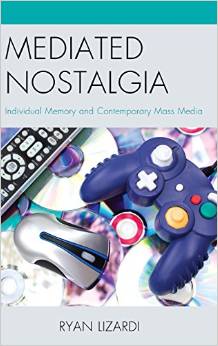Faculty book looks at the past, personal and cultural
In some form or another, we all look back on the past, but Assistant Professor of Digital Media Ryan Lizardi makes it his mission to look at how we get caught in the thralls of nostalgia, and how clear the vision of our own past is. In his new book, Mediated Nostalgia: Individual Memory and Contemporary Mass Media, published by Lexington Books, Lizardi tackles the media’s current obsession with nostalgia and how it presents the past to us in an individualized and idealized form.
 Released in November 2014, Lizardi’s work posits that the cultural implication of constantly returning to nostalgia is an increasing reliance on defining who we are, both as individuals and as a society, based on the media we consumed in our youth. It’s a popular tactic for the media industry, and taking a look at film, literature, television and video games, Lizardi explains why it’s also problematic.
Released in November 2014, Lizardi’s work posits that the cultural implication of constantly returning to nostalgia is an increasing reliance on defining who we are, both as individuals and as a society, based on the media we consumed in our youth. It’s a popular tactic for the media industry, and taking a look at film, literature, television and video games, Lizardi explains why it’s also problematic.
“The book deals with a lot of different media, from television shows set in bygone eras to film remakes of countless classics from the 1970s and 1980s,” Lizardi says. “It is all about how media companies try to exploit and capitalize on what different generations loved when they were children by continually revisiting these same media texts over and over.”
The idea for the book came directly from Lizardi’s research interests in the way media plays a role in our own reflections on the past. According to Lizardi, media messages drive people to believe they loved what they did in their personal past and the past of popular culture, creating an illusion of a shared connection.
He says the media wants people to long for something they had when they are young, and are constantly telling audiences that it is important to always be looking back. That explains why the consumer marketplace offers a constant stream of repackaged material such as special edition DVD box sets, classic Fisher Price toys relabeled as “Fisher Price Classics” and television shows based around the need to visit the past. It also accounts, Lizardi says, for why movie studios reboot their franchises, starting their stories from scratch with new casts and settings, just a few short years after the last film, such as the short, five-year window between the relaunch of Sony’s Spider-Man franchise.
“I found a lot of my smaller projects contained notions about nostalgia and how media asks us to think about the past. Bringing together these smaller elements and trying to posit generalized and broader trends was probably the most interesting part of the whole process.”
While it means less need for original material by media producers, it keeps audiences constantly out of the present and looking to their past for comfort and satisfaction, even if it’s a romanticized past that never truly existed.
“After taking a breath, I would love to follow this research path to further try and understand how media asks us to think about and remember the past. This might entail another book that looks at future mediated nostalgia trends, because they are always changing, but I am also finding myself interested in the idea that decisions about how the past is digitally archived are increasingly being made for us as consumers. Not that we were able to pick which films and games were remade in the past, but that technologies like Netflix and YouTube often choose which media texts from the past are able to be replayed and remembered.”
“Mediated Nostalgia: Individual Memory and Contemporary Mass Media” is available on Amazon.com.
Recent Comments
Archives
- September 2018
- August 2018
- May 2018
- April 2018
- March 2018
- February 2018
- January 2018
- December 2017
- November 2017
- October 2017
- September 2017
- May 2017
- April 2017
- March 2017
- February 2017
- January 2017
- December 2016
- November 2016
- October 2016
- September 2016
- August 2016
- May 2016
- April 2016
- March 2016
- February 2016
- January 2016
- December 2015
- November 2015
- October 2015
- September 2015
- August 2015
- May 2015
- April 2015
- March 2015
- February 2015
- January 2015
- December 2014
- November 2014
- October 2014
- September 2014
- August 2014
- May 2014
- April 2014
- March 2014
- February 2014
- January 2014
- December 2013
- November 2013
- October 2013
- September 2013
- August 2013
- June 2013
- May 2013
- April 2013
- March 2013
- February 2013
- January 2013
- December 2012
- November 2012
